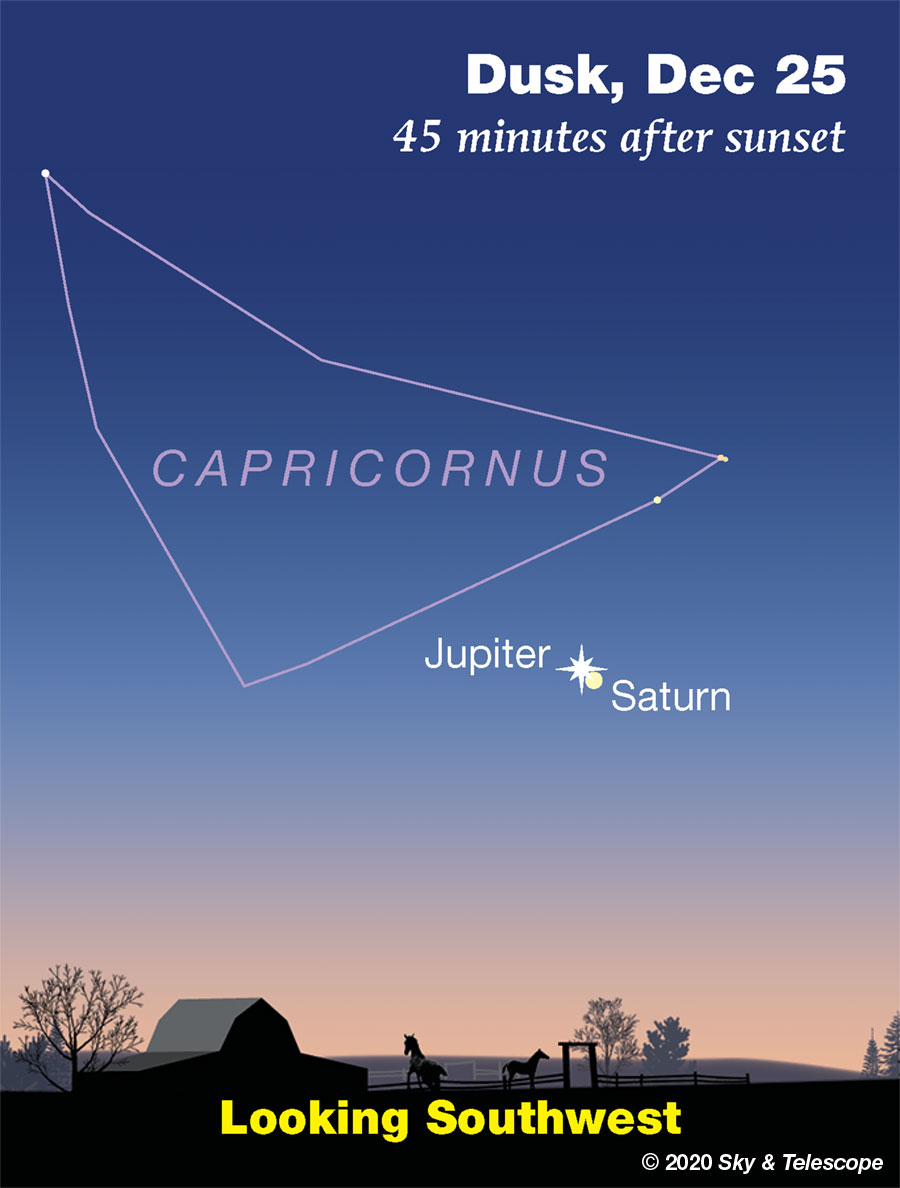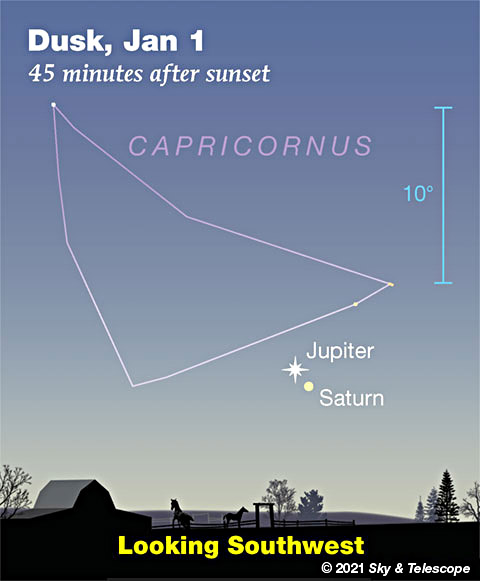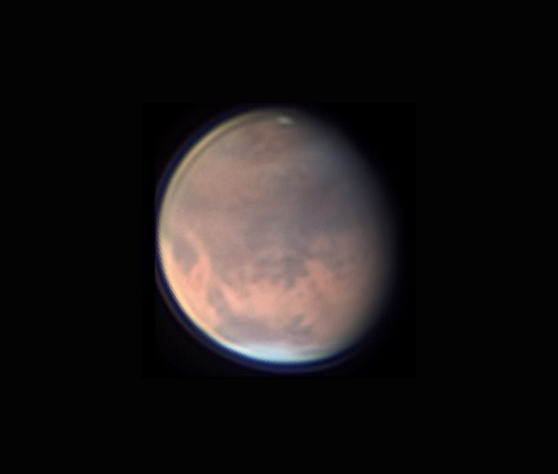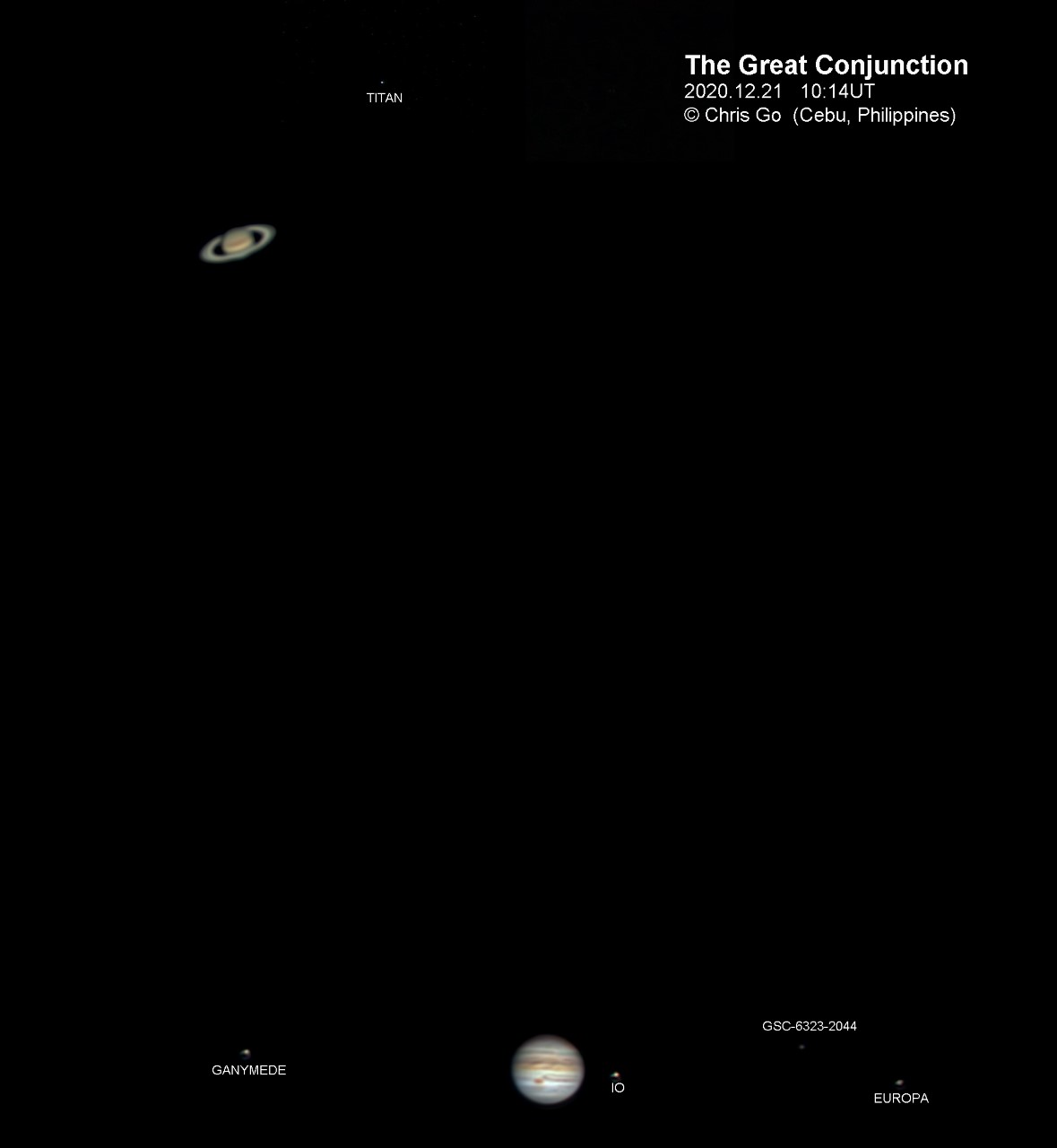
FRIDAY, DECEMBER 25
■ Jupiter and Saturn are moving apart after their December 21st conjunction. Look for them sinking lower in the southwest in twilight, as shown above. Still a striking sight!
■ Algol shines at its minimum brightness, magnitude 3.4 instead of its usual 2.1, for a couple hours centered on 12:27 a.m. EST tonight; 9:27 p.m. PST. Algol takes several additional hours to fade and to rebrighten.
■ Have you ever watched a Sirius-rise? Find an open view down to the east-southeast horizon, and watch for Sirius to come up about two fists at arm's length down where Orion's Belt points to. Sirius rises around 7 or 8 p.m. depending on your location.
About 15 minutes before Sirius-rise, a lesser star comes up barely to the right of there. This is Beta Canis Majoris or Mirzam, a name that means “The Announcer.” What Mirzam announces is Sirius. You’re not likely to mistake them; the second-magnitude Announcer is only a twentieth as bright as the king of stars soon to make its royal entry.
When a star is very low it tends to twinkle slowly, and often in vivid colors. Sirius is bright enough to show these effects well, especially in binoculars. You can make it your annual Christmas star!
SATURDAY, DECEMBER 26
■ The waxing gibbous Moon shines roughly between Aldebaran and the Pleiades. Off to their left sparkles bright Capella.
SUNDAY, DECEMBER 27
■ Now the bright Moon shines left of Aldebaran, by 5° or 6° for North America. Almost three times higher above the Moon are the Pleiades. Capella shines farther off to the left.
MONDAY, DECEMBER 28
■ The Moon is at the horns of Taurus this evening, between Capella far to its upper left, Betelgeuse to its lower right, Aldebaran to its upper right, and Pollux and Castor farther to the Moon's lower left.
■ Algol shines at its minimum brightness for roughly two hours centered on 9:16 p.m. EST.
TUESDAY, DECEMBER 29
■ Full Moon (exact at 10:28 p.m. EST). The Moon shines in Gemini, left of Orion during the evening. It forms a nearly equilateral triangle with bright Capella high above it and orange Aldebaran to their upper right.
The Moon is very geologically dead. But perhaps not entirely so. Rows of relatively young boulders scattered along the tops of some mare wrinkle ridges, those that overlie deep volcanic dikes, indicate something going on in recent geologic times. The boulders are no more than 25 to 300 million years old, just a hundredth to a tenth the age of the plains they apparently emerged from. See Charles Wood's "Exploring the Moon" column in the December Sky & Telescope, page 52, with maps of where they lie.
WEDNESDAY, DECEMBER 30
■ Look a few degrees left and upper left of the Moon, respectively, for Pollux and Castor.
■ This is the time of year when Orion shines in the east-southeast around dinnertime. Look for him tonight far to the right of the Moon. He's well up now, but his three-star Belt is still nearly vertical. The Belt points up toward Aldebaran and, even higher, the Pleiades. In the other direction, it points down to where bright Sirius will rise around 7 p.m. to twinkle furiously.
THURSDAY, DECEMBER 31
■ The Moon is well up in the east-northeast by mid-evening. Above it are Pollux and Castor. Farther right of the Moon shines Procyon, and even farther right of Procyon (and maybe a little lower) is brilliant Sirius.
■ After noise and whoopla on TV at the turning of midnight, step outside into the silent, cold dark. The bright Moon will now be shining high in the southeast. Sparkling less high in the south will be Sirius, with the other bright stars of Canis Major to its right and below it. Sirius is the bottom star of the bright, equilateral Winter Triangle. The others are Betelgeuse in Orion's shoulder to Sirius's upper right, and Procyon the same distance to Sirius's upper left. The Triangle now stands upright, just about in balance, as the Moon looks on.
FRIDAY, JANUARY 1

■ As Jupiter and Saturn continue to draw apart, they're sinking ever lower in the southwest in twilight as shown above. This evening they're 1.3° apart. How much longer can you keep them in view?
SATURDAY, JANUARY 2
■ Just as the stars come out, face due north and look high. Cassiopeia is now a flattened M shape canted at an angle (depending on where you live). Only an hour or so later, the M is horizontal! Constellations passing near the zenith appear to rotate rapidly with respect to your direction "up."
This Week's Planet Roundup
Mercury is out of sight in the glare of the Sun.
Venus (magnitude –3.9, in Ophiuchus left of the head of Scorpius) shines very low in the southeast during dawn.
Mars (about magnitude –0.3, in dim Pisces) shines bright yellow-orange very high in the south in early evening. Mars is fading and shrinking into the distance, but it's still 11 arcseconds wide in a telescope, big enough to show some surface detail during steady seeing. It's gibbous: 89% sunlit from Earth's point of view.

Go images from the Philippines on the opposite side of Earth from North America. So, because Mars also rotates once in about 24 hours, he images the opposite side of Mars in early evening than the side of Mars the Americas see in early evening around any given date.
To get a map of the side of Mars facing you at the date and time you observe, you can use our Mars Profiler. The map there is square; remember to mentally wrap it onto the side of a globe. (Features near the map's edges become very foreshortened.)
Jupiter and Saturn (magnitudes –2.0 and +0.6, respectively) still shine close together, low in the southwest during and after twilight. Jupiter is the bright one; Saturn is only about a tenth as bright. Their separation is widening: from 0.5° on December 25th to 1.3° by January 1st. How long can you keep them in view?
See The 400-Year Rhythm of Great Conjunctions about the cycles of Jupiter-Saturn pairups.

Uranus (magnitude 5.7, in Aries) is high in the south in early evening, about 10° east (left) of Mars. Uranus is only 3.7 arcseconds wide, but that's enough to appear as a tiny fuzzy ball, not a point, at high power in even a smallish telescope with sharp optics — during spells of good seeing.
Neptune (magnitude 7.9, in Aquarius) is lower in the southwest right after dark. Neptune is 2.3 arcseconds wide, harder to resolve than Uranus except in very good seeing. Finder charts for Uranus and Neptune.
All descriptions that relate to your horizon — including the words up, down, right, and left — are written for the world's mid-northern latitudes. Descriptions that also depend on longitude (mainly Moon positions) are for North America.
Eastern Standard Time, EST, is Universal Time minus 5 hours. (Universal Time is also known as UT, UTC, GMT, or Z time.)
Want to become a better astronomer? Learn your way around the constellations. They're the key to locating everything fainter and deeper to hunt with binoculars or a telescope.
This is an outdoor nature hobby. For an easy-to-use constellation guide covering the whole evening sky, use the big monthly map in the center of each issue of Sky & Telescope, the essential magazine of astronomy.
Once you get a telescope, to put it to good use you'll need a detailed, large-scale sky atlas (set of charts). The basic standard is the Pocket Sky Atlas (in either the original or Jumbo Edition), which shows stars to magnitude 7.6.

Next up is the larger and deeper Sky Atlas 2000.0, plotting stars to magnitude 8.5; nearly three times as many. The next up, once you know your way around, are the even larger Interstellarum atlas (stars to magnitude 9.5) or Uranometria 2000.0 (stars to magnitude 9.75). And be sure to read how to use sky charts with a telescope.
You'll also want a good deep-sky guidebook, such as Sky Atlas 2000.0 Companion by Strong and Sinnott, or the bigger (and illustrated) Night Sky Observer's Guide by Kepple and Sanner.
Can a computerized telescope replace charts? Not for beginners, I don't think, and not on mounts and tripods that are less than top-quality mechanically, meaning heavy and expensive. And as Terence Dickinson and Alan Dyer say in their Backyard Astronomer's Guide, "A full appreciation of the universe cannot come without developing the skills to find things in the sky and understanding how the sky works. This knowledge comes only by spending time under the stars with star maps in hand."
![]() Audio sky tour. Out under the evening sky with your
Audio sky tour. Out under the evening sky with your
earbuds in place, listen to Kelly Beatty's monthly
podcast tour of the heavens above. It's free.
"The dangers of not thinking clearly are much greater now than ever before. It's not that there's something new in our way of thinking, it's that credulous and confused thinking can be much more lethal in ways it was never before."
— Carl Sagan, 1996
"Facts are stubborn things."
— John Adams, 1770
*Answer to why the Moon has a younger (slimmer) phase each month now when it passes Mars:
The seasonal turning of sky carries Mars westward month by month, closer toward our line of sight to the Sun (despite Mars's slower eastward motion against the stars). The closer the Moon is to our line of sight to the Sun, the thinner its phase.
 0
0








Comments
You must be logged in to post a comment.